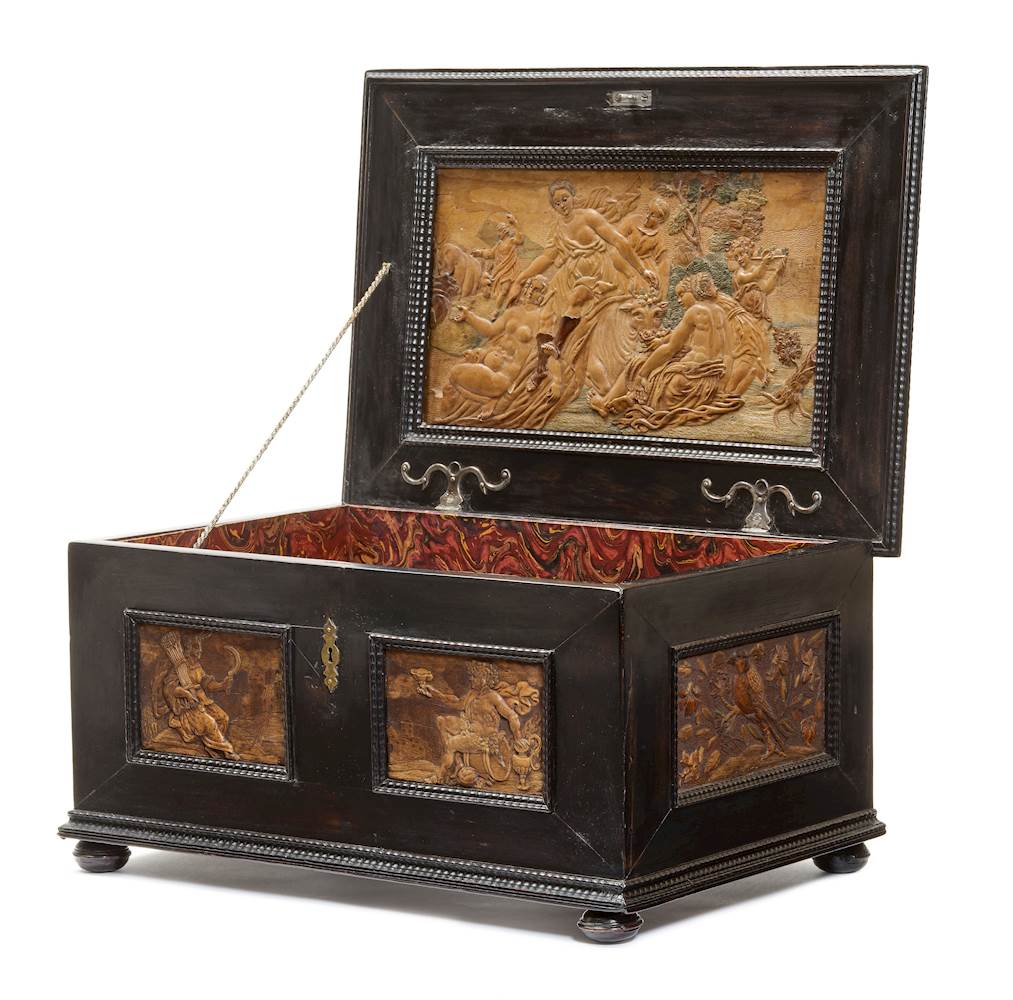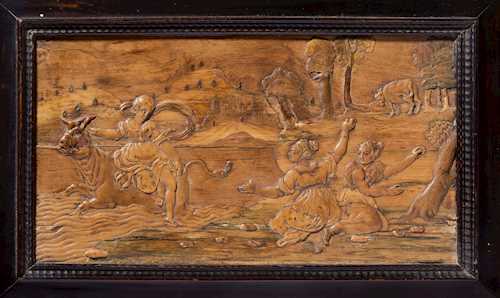
Lot 1049 - A210 Decorative Arts - jeudi, 19. septembre 2024, 14h00
CASKET WITH RELIEF INLAYS
Free Imperial City of Cheb (present-day Czech Republic), 2nd half of the 17th century. The six small relief inlays from the workshop of Adam Eck (1604-1664), ca. 1660/70.
Maple, pear, poplar and wood partly stained and ebonized with figurative relief inlays in rectangular reserves. Rectangular body on a straight profiled frame and flattened feet. Panelled, slightly protruding hinged lid. The inside and outside of the lid with scenes of the abduction of Europa by Zeus in the form of a bull. The front and back with depictions of the four seasons. The side wall with a depiction of a bird and flowers. Iron mounts. The inside of the compartment lined with marbled paste paper.
40 × 28 × 22 cm.
Cracks, small losses to the inlays. Upper lid inlay with filling and loss to the area of the bull's head. Escutcheon later.
Provenance:
Private collection Switzerland.
According to Jochen Voigt, a specialist in Cheb relief marquetry, the two large pictures on the outside and inside of the lid were made by two different workshops. The picture with the Abduction of Europa, visible on the outside, probably comes from an anonymous workshop, which also created the relief inlay picture with the "Rape of the Sabine Women", which can be found on a panel in the Dresden Museum of Decorative Arts (see Jochen Voigt: Reliefintarsien aus Eger. Halle an der Saale 1999, p. 328). Stylistically, the interior can be compared to a relief in the Saxon monastery of St. Marienstern.
According to Prof. Voigt, the six small relief inlays on the front, back and sides are almost certainly from the workshop of the Cheb master Adam Eck.
Relief inlays and marquetry, which show a sculptural dimension as well as a flat one, are a special feature of the workshops from the free imperial city of Cheb (today's Czech Republic). Woods of different thicknesses were used, carved in relief, sometimes dyed and assembled into inlaid pictures. Wonderful caskets, game boxes and small cabinets were created, which enjoyed great popularity among the European nobility and at court. Such relief inlays are considered to be the unique distinguishing feature of the work of the Cheb workshops, so that the name "Cheb cabinets" or "Cheb caskets" became established for them.
The casket is illustrated in: Hendrik Thoss: Saxony in the Thirty Years' War. Diplomacy and politics. In: Uwe Fiedler (ed.): Der Kelch der bittersten Leiden. Chemnitz 2008, p. 27, No. 17.
Provenance:
Private collection Switzerland.
According to Jochen Voigt, a specialist in Cheb relief marquetry, the two large pictures on the outside and inside of the lid were made by two different workshops. The picture with the Abduction of Europa, visible on the outside, probably comes from an anonymous workshop, which also created the relief inlay picture with the "Rape of the Sabine Women", which can be found on a panel in the Dresden Museum of Decorative Arts (see Jochen Voigt: Reliefintarsien aus Eger. Halle an der Saale 1999, p. 328). Stylistically, the interior can be compared to a relief in the Saxon monastery of St. Marienstern.
According to Prof. Voigt, the six small relief inlays on the front, back and sides are almost certainly from the workshop of the Cheb master Adam Eck.
Relief inlays and marquetry, which show a sculptural dimension as well as a flat one, are a special feature of the workshops from the free imperial city of Cheb (today's Czech Republic). Woods of different thicknesses were used, carved in relief, sometimes dyed and assembled into inlaid pictures. Wonderful caskets, game boxes and small cabinets were created, which enjoyed great popularity among the European nobility and at court. Such relief inlays are considered to be the unique distinguishing feature of the work of the Cheb workshops, so that the name "Cheb cabinets" or "Cheb caskets" became established for them.
The casket is illustrated in: Hendrik Thoss: Saxony in the Thirty Years' War. Diplomacy and politics. In: Uwe Fiedler (ed.): Der Kelch der bittersten Leiden. Chemnitz 2008, p. 27, No. 17.
CHF 12 000 / 20 000 | (€ 12 370 / 20 620)









